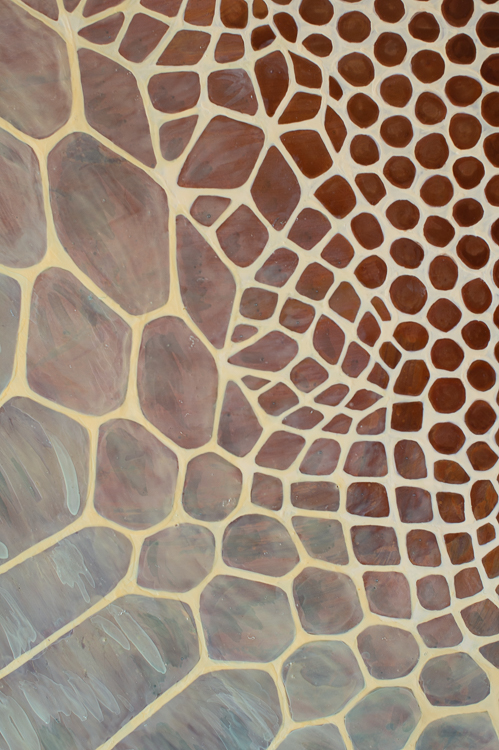Pantherophis obsoletus
18 x 24 inches | Medium: OneShot enamel and urethane on copper, mounted on a birch panel
The Western Rattlesnake, Pantherophis obsoletus, molts or leaves their old skin behind as a natural process of growth. Would that we all could leave our outer layers behind as we grow. The gaussian appearance of a snake’s skin is in direct opposition to the slick, rough skin of the animal.
This painting is part of a series of paintings that focus on the geometric reorganization of plant and animal characteristics into patterns.
Migration
40 x 30 inches | Medium: OneShot enamel and urethane on copper, mounted on a birch panel
The word migration has such anxiety around it in our news, but this is a happy, hopeful story about migration.
The enamel on copper painting is a pattern made up of Monarch butterfly wings. The Monarch travels from Canada through Texas on its way to Mexico. In 2019 they had a sudden population boom, depositing many of them in my backyard in Austin, Texas.
It was around this time that my son was identified as dyslexic and a very special teacher came into our lives. Ms. Joy Marcus, a native of Canada, who studied in Mexico and now teaches in Texas, volunteered to tutor him for two years. It was a relationship that transformed all of us. To thank her for her time, I decided to give her something that represented what she means to me and my son.
The migration of the Monarch aligned so beautifully with the places that shaped Joy’s life, I felt it represented who she is as a person. Butterflies also symbolize transformation, which speaks to her work teaching seven-year-olds to read.
Most people understand that dyslexia makes it difficult for a person to read and spell, but there is so much more to it. Dyslexic minds are often said to be able to see the forest, but not the trees, meaning they can see the bigger picture, but often the details are tricky. It makes them adept at seeing patterns, creating complex systems, and finding connections that are not at once obvious.
It is through my son’s identification as dyslexic that I learned about my own less intense version of dyslexia. It is why I am compelled to create using patterns to form geometric systems and layer in color, form, brushwork, symbolism, questions and stories.
Migration is the key to understanding my larger body of work I call Patternalia. Patternalia is a series exploring the underlying structure of the natural world.
In Migration you can see how my mind works. I have created an elaborate system of interlocking wings that can be enjoyed up close for their individual ornate properties the way a non-dyslexic mind would. Or the viewer can stand at a distance and enjoy the hills and waterfalls, the orange paths that traverses the landscape the way dyslexic minds do naturally.



